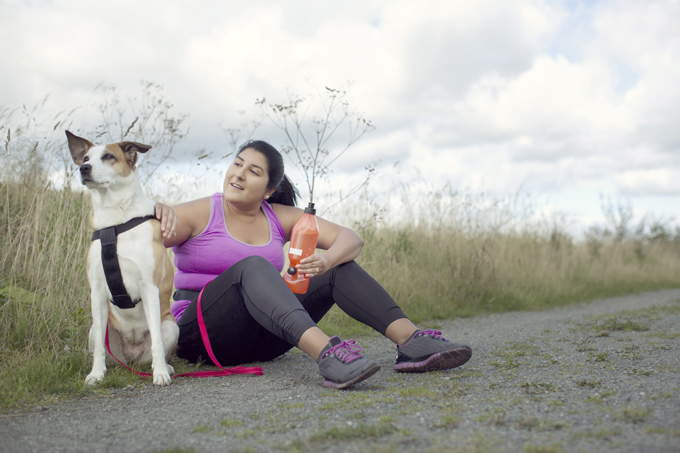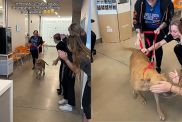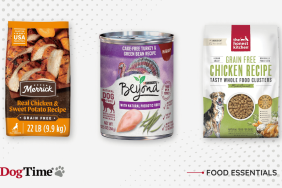“Obesity is a big problem in pets, just as it is with people, and exercising helps keep the dog’s weight down,” said Dr. Susan Nelson, Kansas State veterinarian and assistant professor of clinical sciences. “Dogs also need an outlet to relieve their energy or else they may develop destructive behavior. Your dog is going to be happier and more content if it receives adequate exercise.”
Fortunately, there are several exercises that pets and their people can engage in together to not only improve health, but to enhance the bond they share.
“Exercising with your pet also promotes the human-animal bond,” she said. “People like dogs because of their unconditional love, and dogs are going to be very pleased to have their owners do something with them.”
While exercise is very important, the amount and type of healthy activity will vary with dogs. Factors such as age, breed, weather and general health will influence the amount and the kind of exercise that your dog will need.
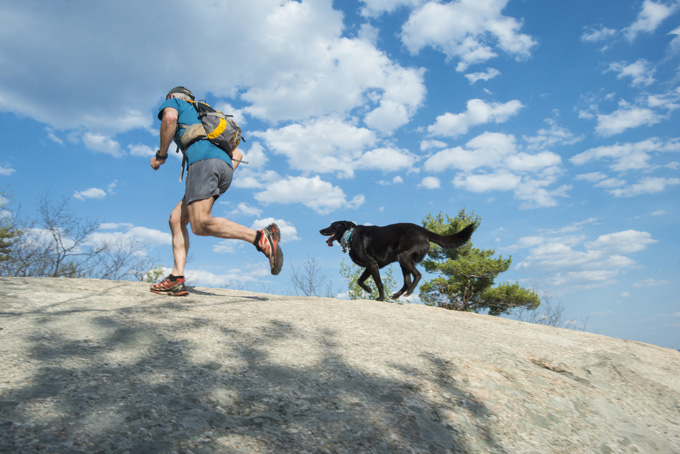
It’s highly recommended that you consult your family veterinarian before engaging Fido in a new routine of physical activity. However, Dr. Nelson offers some helpful, general guidelines:
- In general, larger and working dogs have higher energy needs, and smaller/toy breeds need less exercise.
- Ideally, dogs should get out twice daily for exercise. Times may vary from 15-60 minutes, depending on your individual pet.
- Turning the dog loose in the backyard isn’t enough–aerobic exercise should be continuous with few breaks. Most dogs are content to lie in the sun and only get up for short periods of activity. If the dog has another dog it can run around with outside, that could be sufficient if they spend long periods playing continuously, but don’t rely upon that in most circumstances.
Dr. Nelson also suggests exercises that people can do with their pets, while keeping our individual dog’s needs and interests in mind. Don’t forget, check with your own veterinarian first to be sure the chosen activity is best for your dog!
- Medium and large dogs typically make better long-distance running partners. If your dog can run longer than you are able, you may want to consider biking while having your dog run beside you on leash. Pay careful attention to safety if you choose this option. Smaller dogs are better suited for shorter distance running or walking.
- While many dogs like catching flying discs, be careful to keep the throws low to avoid injury to joints from higher leaps. Herding breeds, such as Border Collies and Australian Shepherds, are dogs that perform well competitively, but there are many other pure and mixed breed dogs that perform equally well.
- Medium dogs, especially herding breeds, are good at agility activities. “That’s not to say that big or small dogs can’t do agility activities, but the herding breeds, overall, are at the top in these competitions,” Nelson said.
- If you like playing fetch with a dog, then a retrieving breed such as a Labrador or Golden Retriever may be your best candidate. While Retrievers are usually best at activities like fetch, many dogs enjoy playing fetch with tennis balls, racquetballs, toys or sticks. Playing fetch indoors with your small breed dog is often a viable option; but if you try this with a larger dog, you could run the risk of enthusiastic, unintentional damage to the inside of your house.
- Swimming is a non-joint stressing exercise for dogs, just as it is for people. It is a great option during the hot, post-summer months when heat exhaustion is a concern. Retrievers are at the top of the pack for this activity.
- Dogs also need mental exercise. Breeds such as Border Collies need a lot of mental stimulation to keep them happy. Activities to consider are searching for hidden items, laser light chasing or completing special tasks.
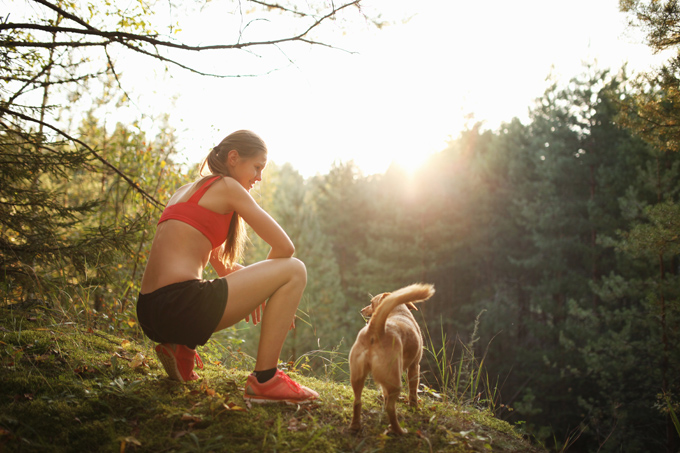
According to Nelson, things to consider when exercising with your dog include:
- Make sure your dog is in shape before doing long or intense workouts. If you want to do a longer distance run, you need to build your dog up gradually to the longer mileage.
- Dogs need to get acclimated to hard surfaces, whether they are going out to walk, run or go hunting with their owners. “If they have been on soft grass in the yard for an extended period of time, and then run on gravel or cement, they may tear up their pads,” Nelson said. “Be mindful also in hot weather that your dog may suffer from burns to the pads from hot cement or asphalt.”
- All dogs are at risk for overheating. Heat, especially combined with humidity, makes it easier for dogs to succumb to heat exhaustion. Be especially cautious with dogs that have short noses, like Bulldogs and Boston Terriers, because they can’t cool themselves as effectively as other dogs due to the conformation of their noses. Dark-haired and long-coated dogs also are at higher risk. If during exercise your dog starts acting woozy, gets a dark red-colored tongue or gets thick ropy saliva, you should stop immediately and get it into a shaded area. Offer water and hose it down with cool water if necessary. For more severely affected dogs, wet them down with water and then take them to a veterinarian immediately.
- Give your dog frequent water breaks while exercising, especially if it is hot out. Limit exercise times to early morning and later in the evenings, and be cognizant of daytime temperatures and humidity.
- Conversely, cold weather also poses special risks to your pet. Frostbite to the feet, nose and ears is possible along with irritation to the feet by ice melts. Do not allow your pet to drink from puddles in the street as they may be contaminated with antifreeze. Short-coated and smaller breed dogs may require a jacket for extra warmth.
- Young dogs, particularly large breed growing puppies, shouldn’t go on long runs until around 12-15 months of age. Up to that time their bones are still growing and elongating. Prolonged, pounding exercise on hard surfaces can potentially cause early damage to their joints.
- Don’t feed your dog right before or right after intense exercise. This may predispose the dog’s stomach to bloat or twist, especially for large breed or deep-chested dogs. A general rule of thumb is to not feed dogs an hour before or after exercising.
